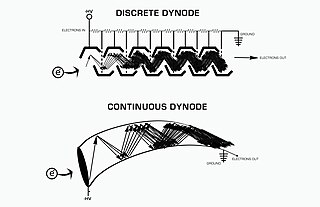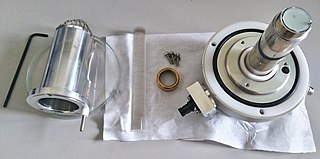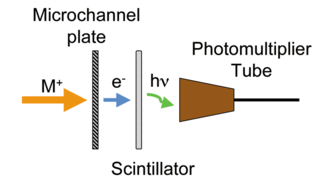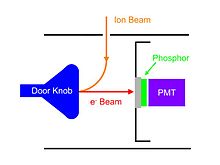
X-ray fluorescence (XRF) is the emission of characteristic "secondary" X-rays from a material that has been excited by being bombarded with high-energy X-rays or gamma rays. The phenomenon is widely used for elemental analysis and chemical analysis, particularly in the investigation of metals, glass, ceramics and building materials, and for research in geochemistry, forensic science, archaeology and art objects such as paintings.

Photomultiplier tubes (photomultipliers or PMTs for short), members of the class of vacuum tubes, and more specifically vacuum phototubes, are extremely sensitive detectors of light in the ultraviolet, visible, and near-infrared ranges of the electromagnetic spectrum. These detectors multiply the current produced by incident light by as much as 100 million times or 108 (i.e., 160 dB), in multiple dynode stages, enabling (for example) individual photons to be detected when the incident flux of light is low.

A scintillation counter is an instrument for detecting and measuring ionizing radiation by using the excitation effect of incident radiation on a scintillating material, and detecting the resultant light pulses.
Mass spectrometry (MS) is an analytical technique that is used to measure the mass-to-charge ratio of ions. They results are presented as a mass spectrum, a plot of intensity as a function of the mass-to-charge ratio. Mass spectrometry is used in many different fields and is applied to pure samples as well as complex mixtures.

A scintillator is a material that exhibits scintillation, the property of luminescence, when excited by ionizing radiation. Luminescent materials, when struck by an incoming particle, absorb its energy and scintillate. Sometimes, the excited state is metastable, so the relaxation back down from the excited state to lower states is delayed. The process then corresponds to one of two phenomena: delayed fluorescence or phosphorescence. The correspondence depends on the type of transition and hence the wavelength of the emitted optical photon.
Liquid scintillation counting is the measurement of radioactive activity of a sample material which uses the technique of mixing the active material with a liquid scintillator, and counting the resultant photon emissions. The purpose is to allow more efficient counting due to the intimate contact of the activity with the scintillator. It is generally used for alpha particle or beta particle detection.
Gamma-ray spectroscopy is the quantitative study of the energy spectra of gamma-ray sources, such as in the nuclear industry, geochemical investigation, and astrophysics.

An electron multiplier is a vacuum-tube structure that multiplies incident charges. In a process called secondary emission, a single electron can, when bombarded on secondary-emissive material, induce emission of roughly 1 to 3 electrons. If an electric potential is applied between this metal plate and yet another, the emitted electrons will accelerate to the next metal plate and induce secondary emission of still more electrons. This can be repeated a number of times, resulting in a large shower of electrons all collected by a metal anode, all having been triggered by just one.

ALICE is one of eight detector experiments at the Large Hadron Collider at CERN. The other seven are: ATLAS, CMS, TOTEM, LHCb, LHCf, MoEDAL and FASER.

The Everhart–Thornley detector is a secondary electron and back-scattered electron detector used in scanning electron microscopes (SEMs). It is named after its designers, Thomas E. Everhart and Richard F. M. Thornley, who in 1960 published their design to increase the efficiency of existing secondary electron detectors by adding a light pipe to carry the photon signal from the scintillator inside the evacuated specimen chamber of the SEM to the photomultiplier outside the chamber. Prior to this Everhart had improved a design for a secondary electron detection by Vladimir Zworykin and Jan A. Rajchman by changing the electron multiplier to a photomultiplier. The Everhart–Thornley Detector with its lightguide and highly efficient photomultiplier is the most frequently used detector in SEMs.
MACRO was a particle physics experiment located at the Laboratori Nazionali del Gran Sasso in Abruzzo, Italy. MACRO was proposed by 6 scientific institutions in the United States and 6 Italian institutions.

The NA62 experiment is a fixed-target particle physics experiment in the North Area of the SPS accelerator at CERN. The experiment was approved in February 2007. Data taking began in 2015, and the experiment is expected to become the first in the world to probe the decays of the charged kaon with probabilities down to 10−12. The experiment's spokesperson is Cristina Lazzeroni. The collaboration involves 333 individuals from 30 institutions and 13 countries around the world.
PERDaix is a novel, small and light weight magnetic spectrometer to measure the charge and mass dependent solar modulation periodically for deeper understanding of cosmic rays. For a better understanding of sources and acceleration of cosmic particles direct measurements of cosmic rays are necessary. Also for a better understanding of the solar modulation which is expected to follow the 22-year solar cycle, time dependent measurements are needed. PERDaix is a newly designed detector which is constructed by the Department of Physics 1b, RWTH Aachen University. Being proposed to the German Space Agency in November 2009 for a participation in the BEXUS Program after a first canceled flight attempt in October 2010 the actual flight took place as a post-BEXUS-campaign flight opportunity in November 2010.
In phosphors and scintillators, the activator is the element added as dopant to the crystal of the material to create desired type of nonhomogeneities.

Total absorption spectroscopy is a measurement technique that allows the measurement of the gamma radiation emitted in the different nuclear gamma transitions that may take place in the daughter nucleus after its unstable parent has decayed by means of the beta decay process. This technique can be used for beta decay studies related to beta feeding measurements within the full decay energy window for nuclei far from stability.

A microchannel plate (MCP) is used to detect single particles and photons. It is closely related to an electron multiplier, as both intensify single particles or photons by the multiplication of electrons via secondary emission, however because a microchannel plate detector has many separate channels, it can additionally provide spatial resolution.

An ion-to-photon detector (IPD) is a component used for detecting ions in mass spectrometry.

X-ray detectors are devices used to measure the flux, spatial distribution, spectrum, and/or other properties of X-rays.

A spectrometer is a scientific instrument used to separate and measure spectral components of a physical phenomenon. Spectrometer is a broad term often used to describe instruments that measure a continuous variable of a phenomenon where the spectral components are somehow mixed. In visible light a spectrometer can separate white light and measure individual narrow bands of color, called a spectrum. A mass spectrometer measures the spectrum of the masses of the atoms or molecules present in a gas. The first spectrometers were used to split light into an array of separate colors. Spectrometers were developed in early studies of physics, astronomy, and chemistry. The capability of spectroscopy to determine chemical composition drove its advancement and continues to be one of its primary uses. Spectrometers are used in astronomy to analyze the chemical composition of stars and planets, and spectrometers gather data on the origin of the universe.













